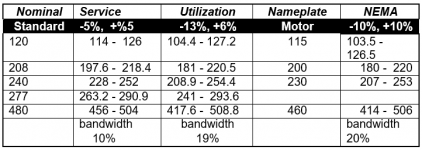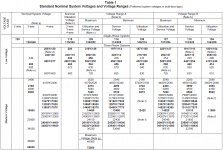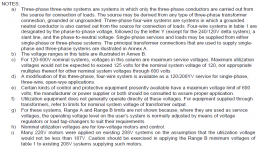- Location
- San Francisco Bay Area, CA, USA
- Occupation
- Electrical Engineer
This subject comes up a LOT in this and other forums, so I thought it would be a good idea to make it a "Sticky" that can be found and referred to easily when it comes up.
There are two "standards" for voltage in North America depending on which END of the wire you are looking at; "Distribution Voltage" (also called "Service Voltage") and "Utilization Voltage", both set forth in ANSI (American National Standards Institute) Standard number C84.1, backed up by IEEE (Institute of Electrical and Electronics Engineers).
The official Distribution Voltage standard for single phase is 120 and 240V, for 3 phase it is 208, 240, 480 and 600. It has been this way since the 1930s after the REA (Rural Electrification Act) during the Great Depression went to bring electricity to farms and rural areas, because the Utilities all did what they wanted to and they didn't see enough profit in it. But because each utility was different at the time, (i.e. 110, 115, 117, 120, 125, etc. etc.), and the REA didn't want to have their service trucks carry around multiple voltage ratings, they picked a "middle ground" of 120/240V and called that the standard. It has been that way since. Later on, standards for the Utility industry came along and added that no matter what they give you, it has to be within +-5%. So for a 120V system, that is between 114V and 126V; for 240V it is 228 to 252V, etc. etc. However many of the older systems still deliver what they used to deliver, regardless of what it is officially called, so yes, there are still pockets of 110V, 220V and 440V out there.
For that reason, industry organizations for manufacturers, such as NEMA (National Electrical Manufacturers Assoc.) developed their OWN standards for the devices that use electricity, and their standard was +-10%, but based on a LOWER voltage, because there is an expected voltage drop from the Service Entrance to where the device connects. So for 120V Distribution, the Utilization voltage is 115V; for 240V it is 230V, for 208V it is 200V, for 480V it is 460V and for 600V it is 575V.
So how that works out is that a MOTOR for example will be built for 230V, +-10%, so it can accept anything from 207 to 253, and because the Distribution Voltage is 228 to 252V, it fits right in. But also if the Utility was still putting out 220V instead of 240V, the LOW end of their range would be 220-5%, so 209V, still within the acceptable range of the Utilization standard.
People however are not swift on the change though, so LOTS of people still refer to residential as being 110/220, or 115/230 or 120/240 (inset joke from the movie "The Money Pit" where Michel Keaton says "220/221.whatever it takes..."). But OFFICIALLY, it is supposed to be 120/240V.
While we are on the subject of "officialdom"; When describing distribution systems that have more than one voltage available, there is a "convention" in the description that should be used to help avoid confusion.
There are two "standards" for voltage in North America depending on which END of the wire you are looking at; "Distribution Voltage" (also called "Service Voltage") and "Utilization Voltage", both set forth in ANSI (American National Standards Institute) Standard number C84.1, backed up by IEEE (Institute of Electrical and Electronics Engineers).
The official Distribution Voltage standard for single phase is 120 and 240V, for 3 phase it is 208, 240, 480 and 600. It has been this way since the 1930s after the REA (Rural Electrification Act) during the Great Depression went to bring electricity to farms and rural areas, because the Utilities all did what they wanted to and they didn't see enough profit in it. But because each utility was different at the time, (i.e. 110, 115, 117, 120, 125, etc. etc.), and the REA didn't want to have their service trucks carry around multiple voltage ratings, they picked a "middle ground" of 120/240V and called that the standard. It has been that way since. Later on, standards for the Utility industry came along and added that no matter what they give you, it has to be within +-5%. So for a 120V system, that is between 114V and 126V; for 240V it is 228 to 252V, etc. etc. However many of the older systems still deliver what they used to deliver, regardless of what it is officially called, so yes, there are still pockets of 110V, 220V and 440V out there.
For that reason, industry organizations for manufacturers, such as NEMA (National Electrical Manufacturers Assoc.) developed their OWN standards for the devices that use electricity, and their standard was +-10%, but based on a LOWER voltage, because there is an expected voltage drop from the Service Entrance to where the device connects. So for 120V Distribution, the Utilization voltage is 115V; for 240V it is 230V, for 208V it is 200V, for 480V it is 460V and for 600V it is 575V.
So how that works out is that a MOTOR for example will be built for 230V, +-10%, so it can accept anything from 207 to 253, and because the Distribution Voltage is 228 to 252V, it fits right in. But also if the Utility was still putting out 220V instead of 240V, the LOW end of their range would be 220-5%, so 209V, still within the acceptable range of the Utilization standard.
People however are not swift on the change though, so LOTS of people still refer to residential as being 110/220, or 115/230 or 120/240 (inset joke from the movie "The Money Pit" where Michel Keaton says "220/221.whatever it takes..."). But OFFICIALLY, it is supposed to be 120/240V.
While we are on the subject of "officialdom"; When describing distribution systems that have more than one voltage available, there is a "convention" in the description that should be used to help avoid confusion.
- If the subject is SINGLE PHASE, the LOWER voltage is listed first, followed by the higher . So a residential single phase system is described as "120/240V".
- If the subject is THREE PHASE, the HIGHER voltage is listed first, followed by the lower. So 480/277V would be correct, 277/480V would not. This is especially important because we have 240/120V 3 phase 4 wire systems available. So by calling it 240/120V you are differentiating it as three phase, compared to 120/240V being single phase.




